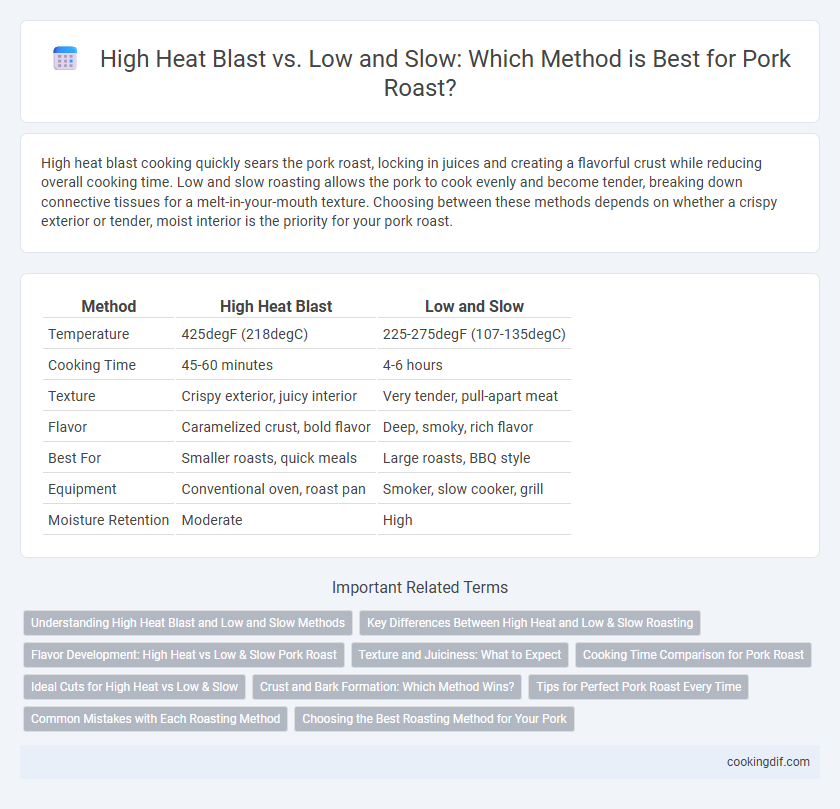High heat blast cooking quickly sears the pork roast, locking in juices and creating a flavorful crust while reducing overall cooking time. Low and slow roasting allows the pork to cook evenly and become tender, breaking down connective tissues for a melt-in-your-mouth texture. Choosing between these methods depends on whether a crispy exterior or tender, moist interior is the priority for your pork roast.
Table of Comparison
| Method | High Heat Blast | Low and Slow |
|---|---|---|
| Temperature | 425degF (218degC) | 225-275degF (107-135degC) |
| Cooking Time | 45-60 minutes | 4-6 hours |
| Texture | Crispy exterior, juicy interior | Very tender, pull-apart meat |
| Flavor | Caramelized crust, bold flavor | Deep, smoky, rich flavor |
| Best For | Smaller roasts, quick meals | Large roasts, BBQ style |
| Equipment | Conventional oven, roast pan | Smoker, slow cooker, grill |
| Moisture Retention | Moderate | High |
Understanding High Heat Blast and Low and Slow Methods
High heat blast roasting sears the pork roast at temperatures above 450degF, creating a flavorful crust and locking in juices quickly, which reduces overall cooking time. Low and slow roasting involves cooking pork at temperatures around 225degF to 275degF, allowing collagen to break down gradually, resulting in tender, melt-in-your-mouth meat with consistent internal doneness. Understanding these methods helps optimize texture and flavor based on desired cooking outcomes for pork roast.
Key Differences Between High Heat and Low & Slow Roasting
High heat roasting sears the pork roast quickly, creating a flavorful crust while retaining juicy interior moisture through short cooking times between 400degF to 450degF. Low and slow roasting, typically at 225degF to 275degF, breaks down collagen gradually, resulting in tender, pull-apart meat with enhanced flavor depth over several hours. The key differences include cooking time, temperature, and texture outcome: high heat produces a firm crust and shorter cook times, while low and slow yields tender, moist roasts with even heat penetration.
Flavor Development: High Heat vs Low & Slow Pork Roast
High heat blast roasting pork enhances Maillard reactions, producing a deep, caramelized crust with intense umami flavors. Low and slow roasting allows collagen breakdown, yielding tender, juicy meat with complex, developed aromas and a uniform flavor profile. Combining both methods can optimize flavor development by balancing surface caramelization and interior tenderness.
Texture and Juiciness: What to Expect
High heat blast cooking creates a crispy exterior and seals in juices, producing a tender yet slightly firmer pork roast texture. Low and slow roasting breaks down connective tissues gradually, resulting in an exceptionally moist and tender meat with a consistently juicy interior. Expect a caramelized crust with a high heat method, while low and slow yields a uniformly soft and succulent pork roast.
Cooking Time Comparison for Pork Roast
High heat blast cooking for pork roast significantly reduces cooking time, often finishing in under an hour by quickly searing the exterior and locking in juices. Low and slow methods extend cooking time to several hours, typically 3 to 5 hours depending on roast size, allowing collagen to break down for tender, flavorful meat. Choosing between them depends on whether speed or depth of flavor and tenderness is the priority.
Ideal Cuts for High Heat vs Low & Slow
High heat blast roasting suits tender pork cuts like loin and tenderloin, creating a crisp exterior while preserving juicy interior textures. Low and slow roasting excels with tougher cuts such as pork shoulder and Boston butt, breaking down connective tissues to achieve tender, pull-apart meat. Selecting the appropriate cooking method based on the cut ensures optimal flavor development and texture in pork roast preparation.
Crust and Bark Formation: Which Method Wins?
High heat blast roasting creates a robust crust and well-developed bark on pork roast by rapidly caramelizing surface proteins and sugars through Maillard reactions. Low and slow cooking produces a tender interior but results in a less pronounced crust due to prolonged moisture exposure and lower surface temperatures. For maximum crust and bark formation, high heat blast is the superior method, delivering enhanced texture and flavor.
Tips for Perfect Pork Roast Every Time
Cooking pork roast at high heat results in a crispy exterior and juicy interior, while low and slow roasting enhances tenderness and flavor through even heat penetration. For perfect pork roast, sear the meat initially at high heat to lock in juices, then reduce to a low temperature to cook slowly and evenly. Use a meat thermometer to ensure the internal temperature reaches 145degF, allowing the roast to rest for at least 3 minutes before carving.
Common Mistakes with Each Roasting Method
High heat blast roasting often leads to uneven cooking and tough outer layers due to rapid moisture loss, while low and slow roasting can result in dry pork if not monitored carefully for internal temperature. Common mistakes include overcooking the exterior with high heat and underestimating the increased cooking time required for low and slow methods, causing inconsistent texture. Proper use of a meat thermometer and resting the roast are crucial to avoid these pitfalls and achieve tender, juicy pork.
Choosing the Best Roasting Method for Your Pork
High heat blast roasting creates a crispy exterior and seals juices quickly, ideal for smaller pork roasts needing a golden crust, while low and slow cooking breaks down connective tissues, resulting in tender, flavorful meat perfect for larger cuts like pork shoulder or Boston butt. Choosing the best roasting method depends on the cut's size and desired texture; high heat suits quick, caramelized finishes, whereas low and slow emphasizes moisture retention and tenderness. Temperature control and timing are critical factors for maximizing pork roast flavor and juiciness in either method.
High Heat Blast vs Low and Slow for pork roast Infographic

 cookingdif.com
cookingdif.com